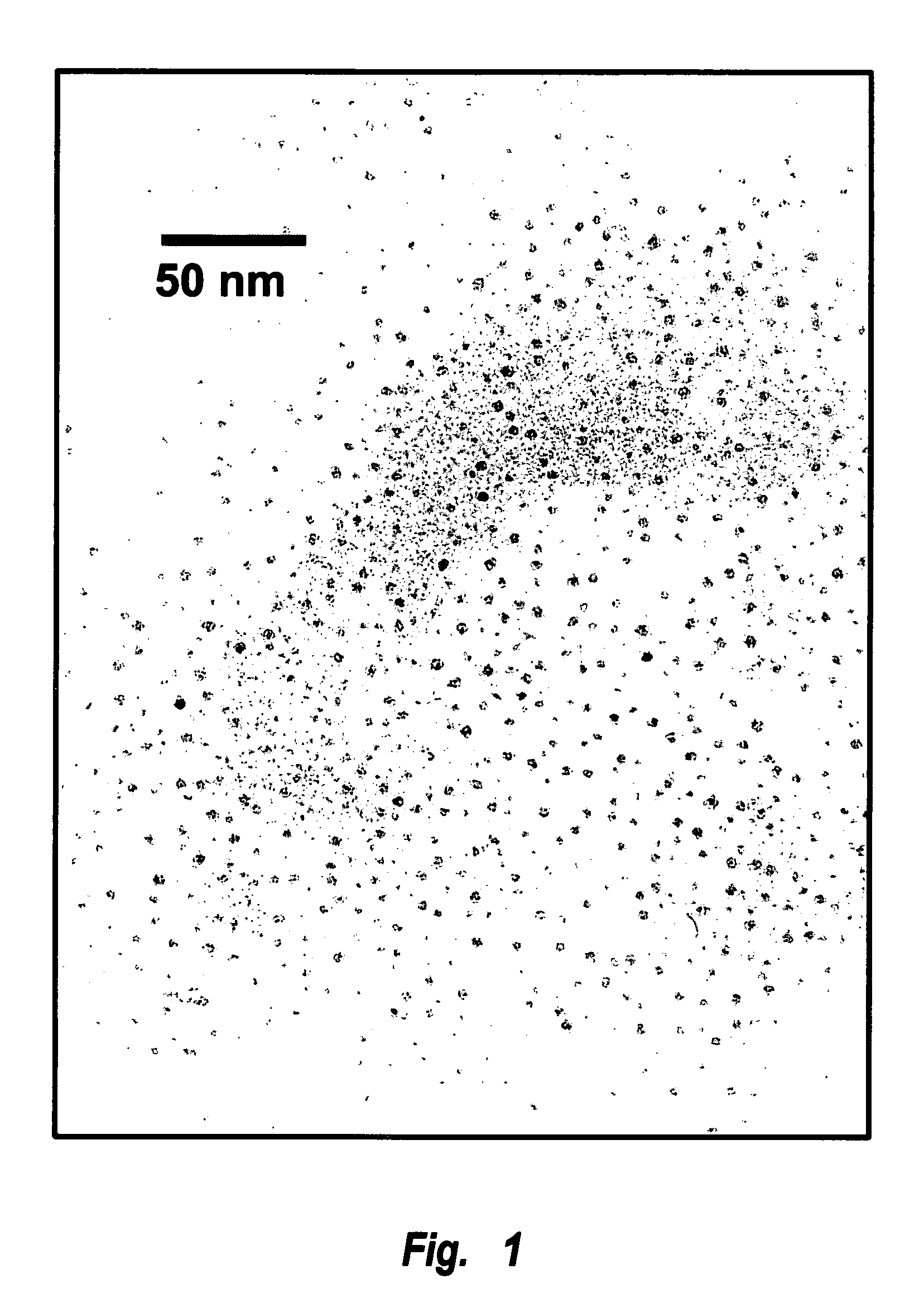Supported nanoparticle catalysts manufactured using caged catalyst atoms
a technology of catalyst atoms and supported nanoparticles, which is applied in the direction of organic compound/hydride/coordination complex catalysts, physical/chemical process catalysts, cell components, etc., can solve the problem of very small catalyst particle formation, achieve high catalyst performance and durability, improve the effect of catalyst performance and durability
- Summary
- Abstract
- Description
- Claims
- Application Information
AI Technical Summary
Benefits of technology
Problems solved by technology
Method used
Image
Examples
example 1
Pt / C Catalyst Preparation
[0062]A 40 wt % Pt / C was prepared using platinum as active component, a conductive support, and glycine as the dispersing agent. The catalyst was prepared using the following steps and concentrations:
[0063](1) 300 mg of Ketjen carbon black was placed under vacuum for 1.0 hr and then impregnated with 40 ml water.
[0064](2) Solution A was prepared by mixing 783.7 mg of an aqueous solution of H2PtCl6 containing 25.52 wt % Pt into 30 ml water.
[0065](3) Solution B was prepared by dissolving 77 mg of glycine in 30 ml water to provide a 1:1 mole ratio of anchoring agent to metal.
[0066](4) Solution C was obtained by refluxing a mixture of solution A and solution B for 1 hour.
[0067](5) Solution C was ultrasonically suspended on the pretreated carbon black for 1 minute. The resulting slurry was dried by heating on a hotplate at 70° C. while stirring, and further dried for 2 hours in an oven at 70° C.
[0068](6) The resulting powder was reduced with 5% H2 (H2 / N2, 5 / 95=V / V...
example 2
PtRu / C Catalyst Preparation
[0070]In example 2, a 30 wt % Pt-15 wt % Ru on carbon catalyst was prepared using platinum, ruthenium, a conductive support, and a glycolic acid dispersing agent. The catalyst was prepared using the following steps and concentrations:
[0071](1) 275 mg of XC-72R carbon black was placed under vacuum for 1.0 hr and then impregnated with 30 ml water.
[0072](2) Solution A was prepared by mixing 587.77 mg of an aqueous solution of H2PtCl6 containing 25.52 wt % Pt into 25 ml water.
[0073](3) Solution B was prepared by adding 22.44 g of 3.3688 mg Ru / ml RuCl3 aqueous solution to Solution A.
[0074](4) Solution C was prepared by dissolving 164 mg of glycolic acid containing 70 wt % glycolic acid into 30 ml water.
[0075](5) Solution D was obtained by mixing solution B and solution C together with 1 ml of 2 M HCl and then refluxing for 1 hour.
[0076](6) Solution D was ultrasonically suspended on the pretreated carbon black for 1 minute. The resulting slurry was dried up on t...
PUM
| Property | Measurement | Unit |
|---|---|---|
| temperature | aaaaa | aaaaa |
| diameter | aaaaa | aaaaa |
| temperature | aaaaa | aaaaa |
Abstract
Description
Claims
Application Information
 Login to View More
Login to View More - R&D
- Intellectual Property
- Life Sciences
- Materials
- Tech Scout
- Unparalleled Data Quality
- Higher Quality Content
- 60% Fewer Hallucinations
Browse by: Latest US Patents, China's latest patents, Technical Efficacy Thesaurus, Application Domain, Technology Topic, Popular Technical Reports.
© 2025 PatSnap. All rights reserved.Legal|Privacy policy|Modern Slavery Act Transparency Statement|Sitemap|About US| Contact US: help@patsnap.com



